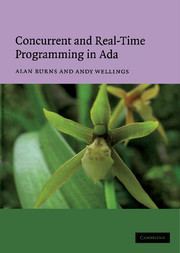Book contents
- Frontmatter
- Contents
- Preface
- 1 Introduction
- 2 The nature and uses of concurrent programming
- 3 Inter-process communication
- 4 Task types and objects
- 5 The rendezvous
- 6 The select statement and the rendezvous
- 7 Protected objects and data-oriented communication
- 8 Avoidance synchronisation and the requeue facility
- 9 Exceptions, abort and asynchronous transfer of control
- 10 Object-oriented programming and tasking
- 11 Concurrency utilities
- 12 Tasking and systems programming
- 13 Scheduling real-time systems – fixed priority dispatching
- 14 Scheduling real-time systems – other dispatching facilities
- 15 Timing events and execution-time control
- 16 Real-time utilities
- 17 Restrictions, metrics and the Ravenscar profile
- 18 Conclusion
- References
- Index
2 - The nature and uses of concurrent programming
Published online by Cambridge University Press: 10 December 2009
- Frontmatter
- Contents
- Preface
- 1 Introduction
- 2 The nature and uses of concurrent programming
- 3 Inter-process communication
- 4 Task types and objects
- 5 The rendezvous
- 6 The select statement and the rendezvous
- 7 Protected objects and data-oriented communication
- 8 Avoidance synchronisation and the requeue facility
- 9 Exceptions, abort and asynchronous transfer of control
- 10 Object-oriented programming and tasking
- 11 Concurrency utilities
- 12 Tasking and systems programming
- 13 Scheduling real-time systems – fixed priority dispatching
- 14 Scheduling real-time systems – other dispatching facilities
- 15 Timing events and execution-time control
- 16 Real-time utilities
- 17 Restrictions, metrics and the Ravenscar profile
- 18 Conclusion
- References
- Index
Summary
Any language, natural or computer, has the dual property of enabling expression whilst at the same time limiting the framework within which that expressive power may be applied. If a language does not support a particular notion or concept, then those that use the language cannot apply that notion and may even be totally unaware of its existence. Pascal, C, C++, Eiffel, Fortran and COBOL share the common property of being sequential languages. Programs written in these languages have a single thread of control. They start executing in some state and then proceed, by executing one statement at a time, until the program terminates. The path through the program may differ due to variations in input data, but for any particular execution of the program there is only one path.
A modern computer system will, by comparison, consist of one or more central processors and many I/O devices, all of which are operating in parallel. Moreover, an operating system that provides for interactive use will always support many executing programs (called processes), in the sense that they are being timesliced onto the available processors. The effect of fast process switching is to give behaviour that is almost indistinguishable from true parallelism. In the programming of embedded systems, one must deal with the inherent parallelism of the larger system. A real-time language must therefore provide some facility for multi-programming. This can be achieved by specifying a standard interface to a multiprocessing operating system or by allowing multiple process systems to be expressed in the language itself.
Ada provides for the direct programming of parallel activities.
- Type
- Chapter
- Information
- Concurrent and Real-Time Programming in Ada , pp. 15 - 30Publisher: Cambridge University PressPrint publication year: 2007

